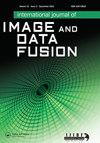Multi-stage guided-filter for SAR and optical satellites images fusion using Curvelet and Gram Schmidt transforms for maritime surveillance
IF 1.8
Q3 REMOTE SENSING
International Journal of Image and Data Fusion
Pub Date : 2021-11-15
DOI:10.1080/19479832.2021.2003446
引用次数: 2
Abstract
ABSTRACT Synthetic aperture radar (SAR) images depend on the dielectric properties of objects with certain incident angles. Thus, vessels and other metallic objects appear clear in SAR images however, they are difficult to be distinguished in optical images. Synergy of these two types of images leads to not only high spatial and spectral resolutions but also good explanation of the image scene. In this paper, a hybrid pixel-level image fusion method is proposed for integrating panchromatic (PAN), multispectral (MS) and SAR images. The fusion method is performed using Multi-stage guided filter (MGF) for optical images pansharpening, to get high preserving spatial details and nested Gram-Schmidt (GS) and Curvelet-Transform (CVT) methods for SAR and optical images,to increase the quality of the final fused image and benefit from the SAR image properties. The accuracy and performance of the proposed method are appraised using Landsat-8 Operational-Land-Imager (OLI) and Sentinel-1 images subjectively as well as objectively using different quality metrics. Moreover, the proposed method is compared to a number of state-of-the-art fusion techniques. The results show significant improvements in both visual quality and the spatial and spectral evaluation metrics. Consequently, the proposed method is capable of highlighting maritime activity for further processing.基于Curvelet变换和Gram Schmidt变换的SAR和光学卫星图像融合多级制导滤波器用于海上监视
合成孔径雷达(SAR)图像依赖于具有一定入射角的物体的介电特性。因此,血管等金属物体在SAR图像中清晰可见,而在光学图像中却难以区分。这两种类型的图像的协同不仅可以获得高的空间和光谱分辨率,而且可以很好地解释图像场景。提出了一种混合像素级图像融合方法,用于全色(PAN)、多光谱(MS)和SAR图像的融合。该融合方法采用多级引导滤波(Multi-stage guided filter, MGF)对光学图像进行全锐化,以获得高保留度的空间细节;采用嵌套的Gram-Schmidt (GS)和Curvelet-Transform (CVT)方法对SAR图像和光学图像进行融合,以提高最终融合图像的质量并充分利用SAR图像的特性。利用Landsat-8操作陆地成像仪(OLI)和Sentinel-1图像主观上和客观上使用不同的质量指标对所提方法的精度和性能进行了评价。此外,所提出的方法与许多最先进的融合技术进行了比较。结果表明,在视觉质量、空间和光谱评价指标方面都有显著改善。因此,所提出的方法能够突出显示海事活动以供进一步处理。
本文章由计算机程序翻译,如有差异,请以英文原文为准。
求助全文
约1分钟内获得全文
求助全文
来源期刊

International Journal of Image and Data Fusion
REMOTE SENSING-
CiteScore
5.00
自引率
0.00%
发文量
10
期刊介绍:
International Journal of Image and Data Fusion provides a single source of information for all aspects of image and data fusion methodologies, developments, techniques and applications. Image and data fusion techniques are important for combining the many sources of satellite, airborne and ground based imaging systems, and integrating these with other related data sets for enhanced information extraction and decision making. Image and data fusion aims at the integration of multi-sensor, multi-temporal, multi-resolution and multi-platform image data, together with geospatial data, GIS, in-situ, and other statistical data sets for improved information extraction, as well as to increase the reliability of the information. This leads to more accurate information that provides for robust operational performance, i.e. increased confidence, reduced ambiguity and improved classification enabling evidence based management. The journal welcomes original research papers, review papers, shorter letters, technical articles, book reviews and conference reports in all areas of image and data fusion including, but not limited to, the following aspects and topics: • Automatic registration/geometric aspects of fusing images with different spatial, spectral, temporal resolutions; phase information; or acquired in different modes • Pixel, feature and decision level fusion algorithms and methodologies • Data Assimilation: fusing data with models • Multi-source classification and information extraction • Integration of satellite, airborne and terrestrial sensor systems • Fusing temporal data sets for change detection studies (e.g. for Land Cover/Land Use Change studies) • Image and data mining from multi-platform, multi-source, multi-scale, multi-temporal data sets (e.g. geometric information, topological information, statistical information, etc.).
 求助内容:
求助内容: 应助结果提醒方式:
应助结果提醒方式:


